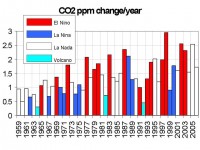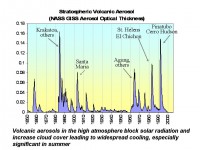By Joseph D’Aleo, November 14, 2009
In a recent UK Telegraph piece, Dr. Ian Plimer, author of the best seller Heaven and Earth argues CO2 is not causing global warming. The Telegraph title is correct but not one of the central themes of the story - that volcanoes are the primary source of CO2 increases. They were in the early days of the planet one of the key sources of all gases, but now other natural and anthropogenic sources dominate. Ian Plimer informs us that is what he told the reporter but the reporter got the facts incorrect.
The Pinatubo eruption was estimated to have emitted only a modest 42 megatons CO2 (Gerlach 1996), a small fraction of the total natural and anthropogenic annual emissions. Major volcanism causes global CO2 level rise to actually decrease significantly for a year following. This can be seen after Agung in 1964, after El Chichon in 1982 and Pinatubo in 1992.
Alan Robock in “Introduction: Mount Pinatubo as a Test of Climate Feedback Mechanisms” (2003) showed a decrease in CO2 rate after Pinatubo, El Chichon and Agung.
He noted “enhanced vegetation growth from more diffuse and less direct solar radiation took more carbon dioxide out of the atmosphere than normal, temporarily reducing the observed long-term increase in carbon dioxide.”
Angert et.a; (2004) looked at whether the “Enhanced CO2 Sink Following the Mt. Pinatubo Eruption Driven by an Increase in Diffuse Radiation?” They noted in their abstract that “following the Mt. Pinatubo eruption in 1991, there was a sharp decrease in the atmospheric CO2 growth rate. It is believed that this decrease was caused by an anomalous strong terrestrial sink in the northern hemisphere. This strong sink is hard to explain, since the global low temperatures that followed the eruption (as a result of the injecting of volcanic aerosols to the stratosphere) were expected to reduce photosynthesis rate. There are currently two competing explanations for the enhanced sink. The first is that soil respiration rate declined more than photosynthesis rate, while the second suggests that the increase in the fraction of diffused radiation, as a result of the aerosol loading, caused an increase in photosynthesis.”
In their study they found that “the enhanced sink cannot be explained by decreased respiration alone, and thus can be only explained by several land and ocean sink mechanisms acting in concert.”
THE OCEANS ROLE
By going further and separating the years by El Nino state and volcanism, we see the importance of the tropical ocean in the CO2 increases. The primary source in the oceans comes from the tropical waters while the cold high latitude waters are sinks for CO2. This is the well known fizz effect from carbonated beverage. When you open a cold beverage it has a lot of fizz (pumped in CO2), let out to sit and warm on the counter and the gas escapes, eventually leaving the beverage flat. Whether a water body is a net absorber or emitter of CO2 is deternmined by Henry’s Law. Equilibrium is established between air and water or the atmosphere and ocean rapidly when CO2 levels change or when water and or air temperatures vary. We see that in both annual and interannual changes.

See large image here.
On average the greatest increases occur in El Nino years, when the tropical oceans are warmest (averaging 1.80ppm/year or 0.54%), much lower rates in La Ninas (1.05ppm/year or 0.31%) and very low rates of increase (0.61ppm or 0.14%) in years of the three major volcanoes. This suggests the major role tropical OCEANS play in CO2 production.
It also suggests that long term changes in the ocean temperatures (the warming since the last little ice age) may be responsible for much of the increase in CO2 observed just as it has in the past. Man after all is directly responsible for only 3-4% of the annual CO2 production (and given the 0.038% trace gas content for CO2, man’s annual contribution represents just 0.0001% of the atmosphere).
And importantly the lifetime of CO2 in the atmosphere contrary to Robock and the IPCC has been definitively shown to be the order of 5 to 6 years (Segalstad 1998) not 100-200 years or as Solomon has speculated 1000 years.
Segalstad (1992; 1993; 1996) further concluded from 13-C/12-C isotope mass balance calculations, in accordance with the 14-C data, that at least 96% of the current atmospheric CO2 is isotopically indistinguishable from non-fossil-fuel sources, i.e. natural marine and juvenile sources from the Earth’s interior. Hence, for the atmospheric CO2 budget, marine equilibration and degassing, and juvenile degassing from e.g. volcanic sources, must be much more important; and the sum of burning of fossil-fuel and biogenic releases (4%) much less important, than assumed (21% of atmospheric CO2) by the authors of the IPCC model (Houghton et al., 1990).

See larger image here.
Read much more about CO2 versus temperatures and how volcano aerosols are an important factor in climate changes on the short term (2 to 4 years) and when they cluster on longer time frames (most of the 1960s) here.




